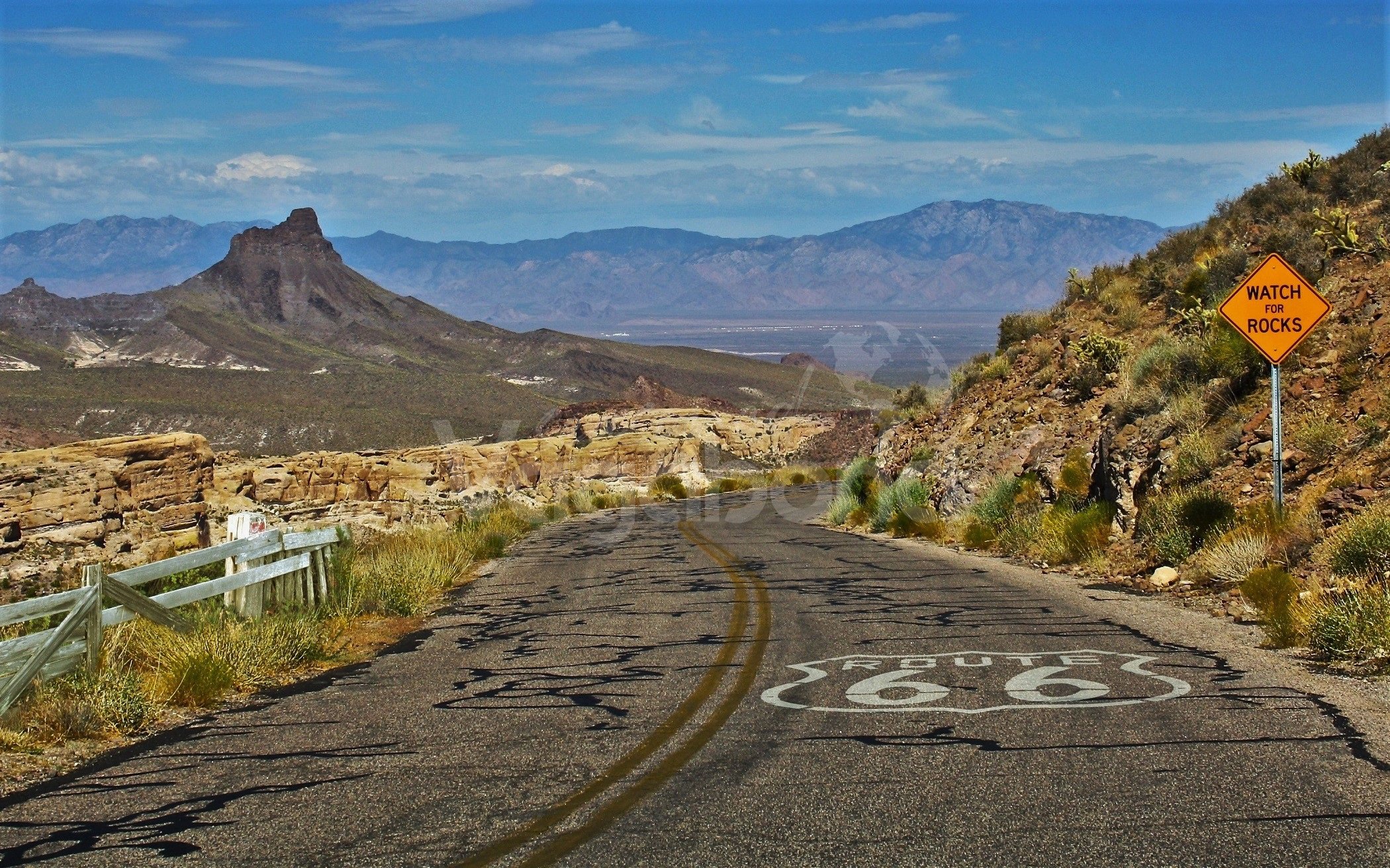
Route 66
A Father Remembers the Mother Road
by Jim Umhoefer
Getting their kicks on Route 66 was not what our 13 and 9 year old kids had in mind as we drove from Hoover Dam to Sedona, Arizona in the fall of 1999.
As the family patriarch and primary driver, I thought it was a wonderful plan. We would be passing through Kingman, Arizona where we had a choice. As I phrased it, we could take the dull, boring interstate (I-40). OR, we could strike off on the most legendary road in the country, Route 66!
It wouldn’t even be that much of a detour. Arizona boasts the longest uninterrupted, two-lane stretch of the original Route 66 (158 miles), compared to the other seven states through which it passes on its classic 2,448-mile journey from Chicago to Los Angeles. From Kingman, Historic Route 66 heads northeast to Peach Springs where it curves back southeast before ending at Mile 139 at the Ash Fork exit on I-40—about 110 miles. Conversely, taking I-40 east bound from Kingman to Ash Fork is about 97 miles.
“Sure, it could take a titch longer on the famous two-lane road, but consider the experience!,” I offered.
“But, Dad, we just want to GET THERE,” my daughter countered.
My wife, who loves back road adventures as much as I do, is also wiser than me when dealing with reluctant offspring. “Let’s just take the interstate, Jim. There will be other chances to wander when the kids aren’t along.” But as the northwest Arizona desert miles stretched on between Hoover Dam and Kingman, my family dozed off. They were still asleep as we entered Kingman. And then, there was the Historic Route 66 sign! So I did what any self-respecting traveling man would do. I turned left onto the Mother Road.
When it opened to traffic in 1926, Route 66 soon became one of the main cross-country arteries in the newly established U.S. Highway system. It was officially called the Will Rogers Highway and was the country’s first all-weather road. Route 66 became a life line to the small, rural towns along the way in an era when extended road travel was a new concept.
The Great Depression of the 1930s spawned a massive migration, as those who wanted to escape the Dust Bowl packed up and left home. Route 66 was the asphalt river that carried migrant families to California, looking for a better life. John Steinbeck coined the term “Mother Road” in reference to Route 66 in his novel, The Grapes of Wrath, which depicted the human struggles of this decade
When World War II ended, Route 66 embodied the country’s postwar economic boom. Thousands of veterans headed west on the highway to start new lives. Vacationing families relied on Route 66 as the fastest way to reach the Grand Canyon and other scenic wonders of the West.
Route 66, which connected the Main Streets of the communities along its way, gained a new nickname, “America’s Main Street.” Its fame skyrocketed in popular culture, starting in 1946 with the blues-based song “(Get Your Kicks On) Route 66” by Bobby Troupe. The song has enjoyed a following of its own, being sung by artists such as Nat King Cole, Chuck Berry, Bing Crosby, the Rolling Stones, Depeche Mode, Van Morrison and many more.
America’s Main Street was also immortalized in the 1960s television series, Route 66.
The show featured two young men on a cross-country adventure in a Corvette convertible. The postwar decades also launched the construction of new interstate highways, often bypassing the small towns that once relied on two-lane roads for their growth and prosperity. Route 66 was one of the casualties of this trend and was decommissioned in 1985. Today, Route 66 is a romanticized symbol of the lure of the open road and the optimism that thrived in the postwar years. A time in which classic cars handled the road’s twists and turns under expansive skies. When mom-and-pop diners and motels welcomed those who pulled off the road in a small town. A time when the friendly attendant washed your windshield while he pumped gas.
THE “GUARDIAN ANGEL of ROUTE 66”
The Mother Road has taken firm root in the psyche of America’s highway culture, benefiting from efforts to preserve its legacy. It is officially recognized as the Route 66 National Historic Trail, part of the National Park Service. Highway signs mark portions of the original road as Historic Route 66 while other sections are part of the National Scenic Byways program. The daunting task of saving Route 66 from being erased by the interstates and time began with a barber and business owner from Seligman, Arizona named Angel Delgadillo.
Angel was born in 1927 along Route 66 in Seligman, Arizona. He watched the exodus of the Okies due to the Dust Bowl in the 1930s and the movement of men and material during World War II. He witnessed the road’s rise in popularity in the postwar years and its decline with the opening of I-40 east of Kingman in 1978.
When the ribbon was cut on the new interstate, it simultaneously cut off the traffic and economic lifeblood of small towns along the famous, but now retired, Route 66.“It was like the tap was turned off and nobody drove through Seligman anymore,” Angel told me while we chatted in his one-chair barbershop on Historic Route 66 during our 1999 visit.
With the loss of traffic and the business that it brought, Angel Delgadillo got busy. He recognized the road’s heritage and fought for its revival. Angel formed the Historic Route 66 Association of Arizona in 1987and ultimately convinced officials to designate Route 66 as a historic highway. Eventually, Route 66 Associations were founded in the other states through which the America’s Main Street ran.
Angel became an attraction himself as people stopped in his shop and the neighboring Route 66 memorabilia store that he and his wife, Vilma, owned. The barbershop is papered with business cards from visitors from around the world. Angel is mentioned in multiple guide books and websites about Route 66. He paused during our conversation to greet tourists from France and Japan who poked their heads in his shop. John Lasseter interviewed Angel in Seligman while researching Route 66 history for the 2006 Pixar movie, Cars.
So it is, then, that the affable Angel became known as “The Guardian Angel of Route 66,” “The Ambassador” and the “Mayor of the Mother Road.”
OUR FAMILY’S MOTHER ROAD ADVENTURE
Meanwhile, I hummed “Get Your Kicks on Route 66” after the left turn onto the Mother Road in Kingman. The late afternoon sun bathed the mountain ranges and sage-covered valleys in a warm glow. The legendary road was right there, singing its highway song under our wheels as it had for legions of other travelers in its heyday.
Not many people live along the route and traffic was light. Route 66 has an intimate feel, as if we were part of the landscape and not just driving through it on a four-lane road. My driving daydreams hit pause as our children stirred. “Where are we?”
“We’re on America’s Main Street,” I proudly proclaimed. “We’ll stay overnight in Seligman along the way and get to Sedona tomorrow.”
“Mo-om!”
Just then, we approached Hackberry, a wide spot in the road where I spied the weathered Old Route 66 Visitor Center and General Store. “Who wants something cold to drink?”
We had stumbled into a time warp. Outside the ramshackle building were vintage gas pumps where a mannequin attendant stood by a mint-condition red and white 1957 Corvette. That got my son’s attention. “Cool!”
As my family sipped soda outside in the sunshine, I chatted with the owners at that time, John and Kerry Pritchard. The inside walls were plastered with license plates and Route 66 keepsakes. A decrepit sign on a fence warned motorists: “300 MILES DESERT AHEAD; WATER BAGS; ICE.” A foreboding skull emphasized the message. That also drew the attention of our kids. On we drove in waning daylight, past Peach Springs on the Hualapai Indian Reservation and Grand Canyon Caverns (maybe another time, I thought).
SELIGMAN, “THE BIRTHPLACE of HISTORIC ROUTE 66”
Just past dusk, we pulled into Seligman and ate a late supper at the famous Copper Cart Restaurant. (The restaurant is now closed but enjoys a new existence as the Copper Cart and Route 66 Motoporium, a gift shop and vehicle museum).
During our 1999 excursion, there were no chain motels in Seligman. We chose the Supai Motel which offered clean but simple accommodations. We watched a movie on the cable TV and fell asleep on Route 66.
Early the next morning, I ventured into the sunny Seligman dawn to buy breakfast groceries while my family lingered in bed. My real hope was to bask in the atmosphere of the “Birthplace of Historic Route 66” before we drove to Sedona. While exploring Main Street, I passed the Rusty Bolt Gift Shop just as the front door swung open for business. A 1959 pink and white two-door Edsel was parked in front with a waving, stocking-foot female mannequin in a poodle skirt standing by the front grille.
Then I came upon a cherry red 1962 Corvette with whitewall tires and a matching tear drop red trailer parked across Route 66 from a barber shop and adjoining gift store. The barber shop door opened and Angel Delgadillo stepped out to greet me with his laughing eyes and engaging smile. He introduced me to his wife, Vilma, and I was more than happy to buy a Route 66 t-shirt and cap to commemorate our adventure. Thus began a conversation in Angel’s barbershop about Historic Route 66 and his role in preserving it. He showed me clippings from around the world, written by journalists who featured Angel in their Route 66 stories.
During our conversation, I mentioned that I was a freelance travel and outdoor writer and photographer. Ever the advocate of his beloved road, Angel then called his two brothers to come to the shop to meet me. When Juan and Joe sat with Angel in front of the barber shop, it was obvious that their humor and grace served them well in life. On that October morning in 1999, Angel was 72, Juan was 83 and Joe was 79.
Juan, the owner of the landmark Snow Cap drive-in with the Dead Chicken sign, built the eatery in 1953 with scrap lumber salvaged from the nearby Santa Fe railway yard. Playful as he was enterprising, Juan’s sense of humor extended to the menu (“cheeseburger with cheese”) and a neon window sign (“Sorry, We’re Open”). Though Juan passed away in 2004, the Snow Cap still serves food and humor, served by Juan’s family.
Back on the Road
With a bag of groceries, some souvenirs and a collection of photos and memories, I joined my family at the Supai Motel. It was time to complete our spin on Arizona’s Historic Route 66 and head on down the road.
The unexpected jaunt on the Mother Road meant more to me than my family, who, for the most part, tolerate my detours. I glanced back at Seligman in the rear view mirror. Though not everyone gets their kicks on Route 66, most of us get what we need.

IF YOU GO
Although it is no longer possible to drive Route 66 uninterrupted all the way from Chicago to Los Angeles, much of the original route and alternate alignments are still derivable with careful planning. Some stretches are quite well preserved, like the segment we explored in northern Arizona.
For a comprehensive resource for all things Route 66, visit the National Historic Route 66 Federation online: www.national66.org








